2013 Dealmakers Outlook
Pharm Exec's annual look at the trends and best practices in biopharm licensing and M&A for the year ahead.
New York's Yankee Stadium was once again the venue for Pharm Exec's annual crack at the bat on trends and best practices in biopharmaceuticals licensing and M&A for the year ahead. Our panel of five experts from big and small pharma as well as academia were joined on February 26 by co-host Campbell Alliance, which provided an advance look at its Survey of Dealmaker Intentions, due for rollout at the BIO Annual Meeting in Chicago later this month. The key findings of the group: dissecting payer preferences well in advance is now the essential "due diligence" for any deal; the debate on whether Big Pharma should scale the ivory tower of partnerships with academia is over; and the next wave of dealmaking involves risky bets on cell-based process and signaling technologies that offer entirely new ways to develop medicines. Never has it been truer that "the art of the deal" is all about stretching the horizon of commercial opportunity beyond what a company can do in-house, by itself. The following is our edited summary of the conversation. —William Looney, Editor-in-Chief.

John Halpern/Photographer
William Looney: Campbell Alliance has conducted its executive-level Survey of Dealmaker Intentions for the past five years; a period that observers would concede has been one of the most volatile in memory. What is distinctive about the past 12 months and how is this weighing on the current business calculations of pharma companies and the host of new partners emerging in this space? Is the market for deals trending up for 2013?
Rich Rieger, Campbell Alliance: We polled 129 key decision-makers here in the United States and in Europe, nearly three-quarters of who rank at the VP level or higher. The focus is on licensing activity rather than M&A transactions. The latest results, indicate that 2012 was a modestly successful year for Phase II and Phase III licensing deals, reversing the downward trend that had been a fixture since we launched the survey in 2007.
I suspect that the overall dealmaking climate might be even more positive if the survey included M&A data, as we are seeing less concern among companies that once regarded M&A's as an option to avoid due to the dilutive impact on earnings. Reliance on in-licensing may be shifting to actual M&A activity. In fact, one approach that is flying high on the radar is the "earn out" deal structure, which is almost a hybrid of the traditional M&A cash back/equity financing model and the milestone payments that drive negotiations in the in-licensing space. The "earn out" is a useful way of establishing a contingent value for an asset, which is attractive to companies that want to better quantify their risk exposure by tying payment to a goal or an event that has to happen. Earn outs are becoming a mainstream practice and in our view will be a central part of dealmaking in the year ahead.
Looney: What about the prospects for deal activity this year?
Rieger: In-licensors and out-licensors are both positive about the outlook for 2013. Significantly, in-licensors continue their interest in early stage [pre-clinical Phase I] assets, for which there is an oversupply in comparison to what is available at later stages. This is particularly true in oncology. Oncology is generating a lot of interest because of the quality of the science and the potential that at least some of these candidates may offer a new mechanism of action compared to existing therapies. However, despite the inventory of attractive assets, investors remain skittish, with some choosing to remain on the sidelines until the technology matures.

When in-licensors were asked about the likelihood that Phase III deals would move forward, some two-thirds of those polled replied with a flat yes, while the opposite was true for out-licensors: little more than a quarter agreed. This disparity was also a highlight of our survey last year; it can be interpreted a number of ways. Differing views about valuations is certainly one, as is the desire of many out-licensors to find a way to develop that asset on their own. Another is the assumption that an asset at Phase III is already sufficiently "de-risked" and therefore can be considered as a full buyout candidate rather than as a licensing partner—the record shows that companies are still willing to pay a premium to acquire full rights to a good drug at this level.
In fact, the big integrated drug makers are sitting on a lot of cash; they have money to spend. If you look back at the premium that companies paid on an acquisition in the 1990s, it was typically about 30 to 35 percent of the acquired firm's market cap. Data I referenced from last year indicates that ratio is now around the 70 percent range. That's a dramatic shift in what Big Pharma is willing to pay for a late stage asset.
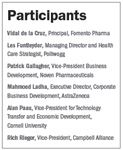
Participants
In my travels to the biotech companies, I hear a consistent message from them: despite the positive buzz about pipelines, Big Pharma is still skittish about investing too early, at pre-clinical Phase I; they would rather wait for the asset to progress and be "de risked," at which point they will pay for the greater level of certainty about the asset's commercial prospects. The problem is that there are fewer of these final-stage assets available.
This is the likely reason for another finding of the survey: two thirds of executives from the in-licensing and out-licensing side expect an upturn in preclinical and Phase I deals this year. For projects in Phase II, the expectations are a bit less optimistic, but still clearly on the positive side. As an observation, I'd say most Big Pharma companies will admit to gaps in their development pipelines; with the increased competition in the de-risked asset class, they will need to spread the net a bit further. Nevertheless, I see no evidence that Big Pharma is ready to turn off the faucet on the more expensive Phase III deals. If the opportunity is right, they will pounce and pay up. The bottom line is that we are back to a period where any asset with potential is going to attract the interest it deserves among buyers, who are willing to go the full M&A route as well as licensing.
Looney: Do these Survey findings concur with what those of you active in dealmaking are seeing in the field today?
Les Funtleyder, Polliwogg: There is a lot of cash out there available for deals, but it is equally true that in the public market the valuations for biotech firms have experienced a big lift—growing at a rate considerably higher than the norm for Big Pharma. No one knows precisely why this is happening: in my recent book, "Healthcare Investing," I suggest it may be due to the inverse relationship between interest rates and biotech investing: when rates are low, biotech assets go higher. The market now expects this—and so the thinking is if you have to pay up anyway, then why not just wait until an asset matures and you can better gauge its commercial potential.
Mahmood Ladha, AstraZeneca: Tax and balance sheet implications aside, our approach to targeting an asset as a licensing opportunity or a direct acquisition is largely agnostic. We focus instead on the asset's stage in its projected lifecycle and on a very close understanding of what the two parties want to achieve in the transaction. This is what is important to us. I'd also comment that, while it is true most companies would prefer deals that involve assets in late stage development, the reality is there are few opportunities right now, especially among Phase III candidates. I'm just not aware of many available that fit our strategy.
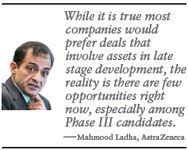
Patrick Gallagher, Noven Pharmaceuticals: We too look for late stage assets, but these tend to be priced much higher than is acceptable under our financial criteria.
Ladha: Timing is very important. We have a good understanding of the assets that are out there at any given point in time. We look at many opportunities and often we decide to take a pass. But then something changes and we come back for a second look, building on the interactions we already had. The trust and knowledge obtained through these prior discussions are put to good use and this time it results in a deal. We did several transactions in the past year that built on previous contacts. The message for us is it pays to be patient; for the seller, it pays to be persistent.
Vidal de la Cruz, Fomento Pharma: My experience is primarily as an out-licensor, which requires a degree of fortitude that is often not reflected in these surveys. I have joked that "BD" isn't an abbreviation for business development but for "Bufo Deosculatore," or, loosely translated, "frog kisser." When you are out-licensing, this is figuratively what you have to do: kiss a lot of frogs and hope that one of them turns into a winner. There are many rejections from potential partners, but we do find that many companies will take another look when there are updates to a program. It's no easy task.
Looney: What does the survey say about the key therapeutic areas of interest this year? Perhaps the courtship is easier when you can find common cause around a particular disease.
Rieger: Oncology and CNS disorders remain the areas of greatest interest. Diseases of the immune system are gaining rapidly, and we see a revival of interest in vaccines and antibiotics. As a category, orphan drugs are the hot ticket along with antibody drug conjugates. Regarding the latter, the buzz is centered on the promise that this will lead to new and better ways to deliver drugs for maximum therapeutic effect. Likewise, the continued commitment around CNS—Alzheimer's disease in particular—prove that the industry is still willing to take the risks and engage in areas where the need is great because the current standard of care is so poor. In the oncology space, there is excitement linked to our increased understanding of the biology and genetics of tumors, which is leading to more personalized treatments. Yet venture capital firms seem to be pulling back a bit in financing oncology start-ups. This is creating more interest in company to company partnership deals that can help fund the next phase of growth.
Funtleyder: We are also seeing strong interest in immunology drugs. Science is finding immunological effects in many chronic conditions, like diabetes. Some experts believe that inflammation is at the root of all diseases.
Looney: We have discussed trends in deal structures, the preferred timelines in product development, and the type of assets that carry the most favor among investors. What about the size of the deal—is bigger still better?
Rieger: There has long been a perception that Big Pharma wants to obtain rights that will deliver blockbuster returns, with revenues in the billion dollar range. We find this to be overstated—the average peak revenue desired by our survey population is $341 million. It's now seen as attractive to have three assets delivering that billion dollars in revenue instead of just one. What matters is the contribution to the full portfolio and the prospect that an asset can be grown out over time, perhaps through additional indications.
de la Cruz: Expectations of revenues also must take account of pricing pressures, which are growing more intense as payers assert a dominant position in formulary access. Everyone is aware that registration approval is not the only parameter that spins revenue anymore: obtaining reimbursement status is the critical hurdle, and it is not guaranteed. Smaller markets are also becoming the norm as the genomics revolution allows for a more stratified, personalized approach to drug therapy. I think the deal environment simply reflects these realities.
Gallagher: In talking deals today, virtually everyone pitches their asset candidate as a $500 million drug. That seems to be what sellers see as the benchmark for optimal performance, one that will bring buyers to the table.
Looney: In interpreting the overall survey, how should drug makers allocate their priorities and resources to maximize their dealmaking potential in 2013?
Rieger: It is important that dealmakers approach opportunities with a greater degree of flexibility than was the case in the past. Clearly, the "earn out" concept is here to stay and a lot of your partners will expect this as an element in negotiations. The boundaries between traditional licensing and actually acquiring an asset are blurring, so success will go to those who embrace a more creative approach.
Another requirement is to be well positioned to take advantage of the oversupply of assets in areas like oncology. Finding the best deal here requires close attention to due diligence and building a foundation of trust with potential partners—before negotiations begin.
Finally, the skills set for dealmaking is expanding. Companies must make the appropriate investments to keep pace. For example, pricing and market access capabilities are now essential to understanding the level of risk in considering an asset. This function has to be included early on in any evaluation or negotiating team. Many people we spoke to on the in-licensing side noted that the offers submitted to them lacked detail on the asset's pricing and reimbursement prospects. For early-stage assets, this is particularly important because such considerations can—and should—influence the design of clinical trials well into Phase III. We also see pricing expectations becoming central to the negotiation of milestone payments. Did the compound obtain a Tier II position on the formulary with no restrictions? Or did it get Tier III with prior authorization and step therapy restrictions? The financial implications are considerable, so the parties to a deal want more specific guarantees around access.
Looney: From a company perspective, what are the mission-critical issues you confront right now in advancing "the art of the deal?"
Gallagher: Noven is a specialty pharma company, a seeker of novel products in niche segments like women's health and ADHD. Our target horizon is focused on the lower half of that zero to one billion dollar asset range. When we look for product opportunities, we start with the assumption that all candidates we can access will carry some flaws; if that was not the case, the big players would have already grabbed it. Hence it is becoming much harder for a company our size to find the good deal, especially because the majors are no longer so picky in focusing only on assets with that billion dollar revenue potential. They are prepared now to outbid us for even the smallest products. Competing with the majors for good, available deals is thus a major strategic challenge for us. Likewise, a company must negotiate with the awareness that margins from a licensed asset are going to be constricted. This is due to cost controlling factors ranging from higher Medicaid rebates to the market power that PBMs wield in controlling access to patients.
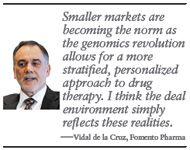
Alan Paau, Cornell University: As an academic enterprise, Cornell concentrates on finding deals at the very earliest stages of the product cycle—much earlier than those of you in industry. We have high hopes about adding to the future drug pipeline through our expertise in molecular biology, which gives drug developers a better understanding of the mechanics behind disease. Cornell is also striving for a more global orientation so that we can expand our range of partners. Because all of our efforts are focused on out-licensing, the challenge we face is ensuring we obtain a good balance between risk and benefit in negotiations with a partner. Royalties and milestone payments are our fixation. We want to get the opportunities we discover into the hands of an industry partner as quickly as possible. The goal is to monetize the knowledge we generate by working with others with the skills to commercialize it. We have no plans to develop drugs ourselves.
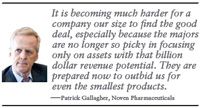
Looney: How do you assess the state of the relationship between the academic enterprise and private industry? Are you both communicating in the same language?
Paau: The spirit of partnership is proliferating, but there are cultural issues that create barriers and complicate a negotiation. Universities exist to generate and spread new knowledge. We are not used to keeping trade secrets, nor are we familiar with putting conditions on whether a researcher or faculty member can talk to someone deemed to be a competitor. Academic culture is freewheeling and internal rules are not always understood. I often face situations where an industry executive will show up in my office and say he is prepared to enter a partnership with a professor and his research team on the basis of a verbal assurance that the professor wants to do it. This may, or may not, be in the university's interest. It falls to me to sort it out, and many times the industry representative will claim he has been misled. To be honest, we are not reinforcing the basic message that if industry wants to create a business partnership with any representative of the university, it must start with us in administration.
Hence you can see that communication is exceedingly important to a productive relationship. Industry has been slow to recognize that academic institutions operate as non-profits. The laws that govern us are quite different than those for a profit making enterprise. For example, Cornell must be careful about the license terms we can agree to. The university sells hundreds of millions in tax-free bonds to investors. The IRS provisions that allow us to float these bonds free of tax requires that we cannot predetermine a value on inventions that we have not yet created. Violation of the rule would mean a loss of our bondholders' ability to receive their interest payments tax-free and hence our right to sell these bonds, a right that is worth far more to us than any deals with industry. This is why when a company comes in and sponsors research with us, we give the company a first right to license, no more.
Looney: What is your pressure point on the academic side? Do you have targets or objectives set forward in your role as an advocate for deals and technology transfers with industry?
Paau: It varies from one institution to another. At Cornell, the revenue target is set reasonably low—my operation is expected not to lose money; income should at least match expenses. But in terms of disseminating our knowledge widely, we are expected on an annual basis to place about half of all new internally generated inventions in technology disclosed to my office in the hands of a commercial enterprise. This is about the highest knowledge transfer target of any university in the United States. We have every incentive to get a deal done. And it's not the price point, or the dollar value, that counts here. Instead, it's being able to put the inventions in the hands of capable partners, so that these inventions can be developed, applied, and used as commercial products.
Looney: Any additional comments about the key priorities that should drive dealmaking this year?
Funtleyder: A fair and accurate assessment of asset value drives success in today's volatile dealmaking climate. Even though overall market conditions are improving, you have to pick your spots. With regard to the assets and willingness to commit among public companies, there is a lot of enthusiasm but less value. For privately held firms, it is the opposite: less enthusiasm and more value. Ultimately, however, valuations are determined by the perceptions of buyers and sellers about risk. One trend we see is growing concern about the sustainability of pricing for biologic drugs: the federal health reform law and private payers are putting the bull's eye on these big ticket therapies. Conversely, the timing is right for diagnostics, genetic sequencing and other technologies that allow for evidence-based treatment. These segments will flourish because the only realistic solution to the cost curve is to follow the data toward better outcomes.
Another growth area for future deals is digital health. These accessible, personalized, and user-friendly technology platforms hold great promise in improving the woeful rate of patient compliance with medicines; billions in revenue are left off the table due to the inability of drug makers to solve this problem. This is a hot area for dealmaking, at least for companies committed to leadership in leveraging communications technology. Clever, forward-looking industry players have noted the convergence of services, diagnostics and therapeutics in creating a superior value proposition for clinicians, patients, and payers.
Ladha: Deal prospects are going to depend more heavily on the best evidence, for the right audience, at the right time. Even smaller companies are now thinking about building the case for reimbursement by generating real-world evidence from the earliest stages of the clinical trial process. You have to design trials so you can demonstrate not only safety and efficacy but economic enhancements as well. Doing this well and early will differentiate the quality of the asset against others in its class. If an asset seller has incorporated that line of thinking into its development plan, we do sit up and take notice. Our groundbreaking partnership with Healthcore is evidence of the strategic approach we now take in developing real-world evidence.
Looney: AstraZeneca is notable for moving its business development team and placing it directly in the R&D unit. What attributes does this structure bring to the dealmaking process? Has it been transformative?
Ladha: Business development activities have always been an important element in our R&D strategy. Previously, the entire business development team reported in a straight line to our CFO. What actually changed is that we became a flexible unit with members deployed into R&D as well as various commercial and corporate functions, depending on need. That is the key: we go to where our contributions are required. One important aspect of the restructure is that it allows us to deepen our contacts at the early development stage, where we work closely with the scientists. It ensures that all internal players will have a close understanding of our strategy in distinct therapeutic areas and how we can achieve this strategy in terms of both our internal portfolio and where we can add value from opportunities outside the company.
Paau: Our experience has been that when we have an idea or an asset in a specific area we are less successful if it is presented to the in-house R&D people with an existing stake in the same area. The "not invented here" syndrome in Big Pharma is very real. If they didn't invent it, it can't be that good.
Looney: So who then do you in academia prefer to work with?
Paau: We prefer a two-step process, starting with a dialogue among technical experts who know the questions and answers that any potential licensee should require in vetting the scientific integrity of the asset. Then if we come back it is important we interact with someone with the authority to make a decision. You would be surprised how often there is no one in the room empowered to act.
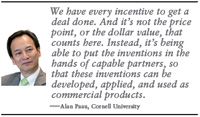
Gallagher: This dance among partners is a vital indicator of the success of any deal. The choreography is complex, particularly when we, as a small company, work with Big Pharma. Each party marches to a different drum, and this is reflected in the pace of decision making: the bigger the company, the slower the pace. With more at stake, small companies cannot tolerate long periods where nothing happens, yet this is fairly common in our interactions with the majors. My advice? Prepare for the long haul and incorporate that into your negotiating plan.
On a positive note, things have changed from the day when the big companies always thought they had the edge on talent. The perception was that if you weren't employed by the majors, you weren't a contender. Today, biotech and the smaller companies are treated as equals, largely because there is so much talent migration—from Big Pharma to biotech, from branded to generic, etc. This tends to allow people to relate better to others, and to understand what the opposite side of the table wants to secure from a particular deal. Establishing that hierarchy of need early on is in my experience one of the most critical success factors in negotiations.

Looney: I'd like to conclude with your assessment of how the dealmaking world is likely to change over the next three-year planning cycle in biopharmaceuticals. What are the game-changers looming on the horizon and how should companies prepare?
Funtleyder: The Jumpstart Our Business Startup [JOBS] Act enacted by Congress last year is a crucial piece of legislation that will have a significant impact on the capital markets that help finance pharmaceutical innovation. Among other things, it will shape the size of certain deals, add new players to the financing roster through encouragement of "crowd funding," and ease the terms for registering for IPOs. Venture philanthropy as a pathway to drug development will gain momentum. In summary, the JOBS Act democratizes the stakes in bringing assets forward; some of the new players will succeed, others will stumble. Everyone from entrepreneurs and billionaires to patients groups are going to be empowered to intervene more in the choices that drug companies make in funding drug development. It changes the dynamic where right now an individual can invest her life savings in a Malaysian mining company but is barred from buying into an early stage Parkinson's disease research company in the hope of finding a cure for her own mother. It will require great skill for dealmakers in sorting all this out. But I am confident that in three to five years we will see a lot more assets turning up—taken off the shelf—because they have been better capitalized with this new money.
Rieger: The major change underway is the decline in the autonomy of the physician in favor of the payer, to the point where any business development assessment will need to begin with agreement on whether the payer will pay. The next few years will also see a tipping point on pricing for biologics and specialty drugs for oncology and other rare individual diseases. Specialty segments are getting crowded and by 2015 payers and insurers will have more choices, making the industry a price-taker. Patients will need to be recruited to defend the pricing status quo. Overall, the pressures on pricing must be baked in now to the valuation of these assets.
Ladha: The dealmaking future is hard to predict; it seems from my experience that for any deal to go through, a million parts have to fall into place. The one enduring truth is that innovation—in the end—does get rewarded. Deals are always going to get done for assets that are innovative and advance the prevailing standard of care. It matters less if that deal is in the form of a license or an acquisition or contains an "earn out" provision or contingent value rights—what it provides for clinicians and patients will drive the returns. I also believe that investors will remain tolerant about the timelines for recouping their investment, if the product and value proposition is right. I am also positive about the contributions we are beginning to tap from the growth of emerging country markets—the question is finding ways to leverage these ideas and bring the world together. Emerging markets will be the source of much new competition, and we need to know their industries better. Deals can help drive this.
Paau: The vital thread for us in academia is that pharmaceutical companies are much more willing to partner. The debate on climbing the ivory tower is over. I see this sentiment only growing more pronounced the remainder of this decade, and the mutual learnings from these ties are going to result in new and better medicines.

William Looney is Pharm Exec's Editor-in-Chief. He can be reached at wlooney@advanstar.com.

Novo Nordisk, The United Laboratories Ink Exclusive License Agreement for Triple Receptor Agonist
March 25th 2025Under terms of the license agreement, Novo Nordisk will acquire the rights to develop and commercialize UBT251 outside of China for obesity and type 2 diabetes for an upfront payment of $200 million.